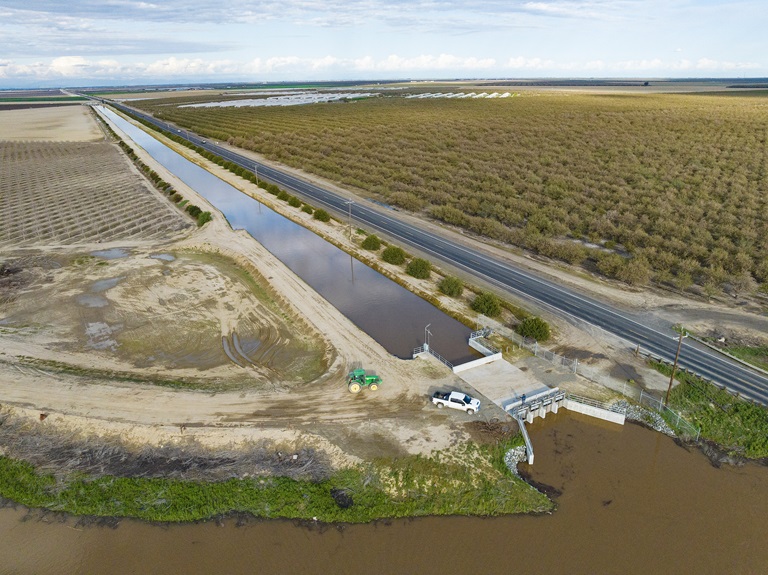DWR Concludes Groundwater Awareness Week Activities and Releases Update on Statewide Groundwater Conditions
This groundwater recharge project’s headgates are seen on a bank of the Kings River is shown in this photograph taken via drone. Photo Taken March 13, 2023.
Each year, DWR celebrates National Groundwater Awareness Week by distributing information and educational materials that increase the public’s understanding of groundwater. As part of an ongoing effort to promote groundwater awareness and provide the latest groundwater information, DWR has just released the newest Semi-annual Groundwater Conditions Update, which includes a look back at the previous water year informed by DWR’s groundwater data and tools. New this year, the report also includes data reported by groundwater sustainability agencies as required under the Sustainable Groundwater Management Act (SGMA).
"We are seeing how local and state efforts to monitor groundwater conditions are really paying off,” said Paul Gosselin, DWR’s Deputy Director of Sustainable Groundwater Management. “With the extreme changes in climate that we are experiencing, including swings of flood amidst prolonged drought, this data is driving decision-making now and into the future.”
The data used in the conditions report pre-dates the series of atmospheric river storms that started hitting California in late 2022 and continues in this first quarter of 2023. Future groundwater updates will start to show the effects from these storms, as well as runoff from this year’s record-breaking snowpack. We expect to see improvements to groundwater conditions from both natural and managed recharge during these storm systems, but it will take several years, or even decades, of normal or above average wet conditions combined with appropriate management actions to counter past decades of groundwater depletion.
Some key findings from the March 2023 Groundwater Conditions Update are noted below and illustrate the impacts of long-term drought and dry conditions on groundwater basins in California. Additional details are included in the full report.
- Sixteen of the last 23 years have had below average precipitation and 13 of these years were classified as “Dry” or “Critical” water years, resulting in a cumulative deficit of over 50 inches of precipitation, on average statewide since 2000, and thus, an increase in groundwater use during those years.
- Recent storms are refilling reservoirs and contributing to an above average snowpack for Water Year 2023, however groundwater basins remain depleted and are extremely unlikely to recharge to pre-drought conditions this year.
- Fifty-five percent of groundwater level measurements collected in fall 2022 (August through October) are at or near historic low measurements, and 36% of measurements are the lowest on record.
- Fall 2022 groundwater levels were at or below the levels at the end of the 2012 - 2016 statewide drought despite the occurrence of two above average years (2017 and 2019) and a wet start to Water Year 2021.
- Over the last 20 years, more than 46 percent of statewide monitoring wells had a decreasing trend in groundwater levels.
- The Sacramento River Region experienced the greatest relative increase in areas and rates of subsidence in Water Year 2022.
- A total of 1,494 dry wells were reported in Water Year 2022, the most of any year since the dry well reporting program started in 2013.
Groundwater is a vital resource in California that supports communities, agriculture, businesses, and the environment. In the spirit of groundwater education, DWR kicked off this year’s Groundwater Awareness Week on March 5 with an informative public event that included short presentations from seven highly respected professionals with varying backgrounds and perspectives, providing insights and an understanding of groundwater.
Groundwater Awareness Week may be over, but for DWR and local groundwater sustainability agencies throughout the State, groundwater awareness and sustainable management is a year-round effort. These agencies are continually working to gain new knowledge and understanding of the complex groundwater system beneath our feet through monitoring, data analysis, use of innovative technologies, and reporting.
Groundwater acts as a drought buffer, providing much-needed water supplies during dry and drought conditions when surface water is lacking. It’s important to replenish groundwater during wet years. Groundwater recharge is a key strategy to improving groundwater conditions throughout the State, and managing through climate-driven weather extremes, including prolonged drought and periodic intense storm events.
Last week, Governor Newsom issued Executive Order N-4-23 which maximizes the ability for groundwater recharge to occur through both natural recharge on open and working lands, and diverting water to active recharge facilities. In support of the Executive Order, DWR will continue to support local agencies to capture available water for groundwater recharge over the next several months, through June.
DWR is proactively facilitating targeted outreach to key areas where spring runoff is anticipated to be high, so that planning and coordination can occur between local groundwater managers, irrigation districts and landowners who have infrastructure or open land available to take water for groundwater recharge, with reservoir operators who may be making planned reservoir releases in the coming months.
In 2021 and 2022, DWR awarded $68 million to 42 groundwater recharge projects that provide nearly 117,000 acre-feet of potential recharge capacity. DWR will award additional grants in 2023 based on available funding. (Applications for this funding include 52 groundwater recharge projects totaling $211 million in estimated cost.)
Since the enactment of SGMA in 2014, the State and local agencies have made tremendous improvements to the frequency of collecting, reporting, and disseminating groundwater data. DWR’s Groundwater Conditions Updates are part of the informational resources associated with DWR’s California’s Groundwater (Bulletin 118), a compendium of groundwater information and data developed every five years.
For a statewide summary of Water Year 2022 water conditions, see DWR’s Water Year 2022 Brochure. The most recent groundwater data is available on the California’s Groundwater Live website, which is updated on a daily basis as data is received by DWR. Additional data and information are available in the CNRA Open Data and Water Data Library websites.
